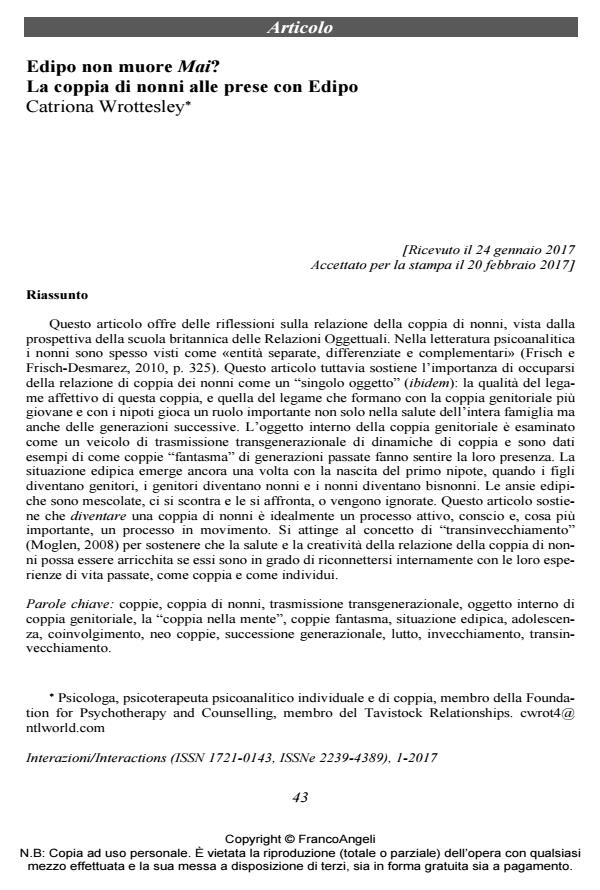Does Oedipus Never die? The grandparental couple grapple with Oedipus
Journal title INTERAZIONI. Clinica e ricerca psicoanalitica su individuo-coppia-famiglia
Author/s Catriona Wrottesley
Publishing Year 2017 Issue 2017/1
Language Italian Pages 27 P. 43-69 File size 258 KB
DOI 10.3280/INT2017-001003
DOI is like a bar code for intellectual property: to have more infomation
click here
Below, you can see the article first page
If you want to buy this article in PDF format, you can do it, following the instructions to buy download credits

FrancoAngeli is member of Publishers International Linking Association, Inc (PILA), a not-for-profit association which run the CrossRef service enabling links to and from online scholarly content.
This paper offers thoughts about the grandparental couple relationship, viewed through a British Object Relations lens. In psychoanalytic literature, grandparents are frequently re-garded as «separate entities, differentiated and complementary» (Frisch and Frisch-Desmarez, 2010, p. 325). This paper, however, argues for the importance of attending to the grandparental couple relationship as "single object" (ibidem): the quality of the affective link between this couple, and of the link they form with the younger parental couple and grandchildren play an important part not only in the well-being of the entire family but also of subsequent generations. The internal parental couple object is examined as a vehicle of transgenerational transmission of couple dynamics and illustrations of how "ghost" couples from previous generations make their presence felt, are given. The Oedipal situation comes to the fore once again with the birth of the first grandchild when children become parents, parents become grandparents, and grandparents become great grandparents. Oedipal anxieties are stirred, to be engaged and struggled with, or avoided. This paper maintains that becoming a grandparental couple is ideally an active, conscious and, importantly, an ongoing process. The concept of "transageing" (Moglen, 2008) is drawn on to argue that the health and creativity of the grandparental couple’s relationship may be enriched if they are able to reconnect internally with their earlier experiences in life, as a couple, and as individuals.
Keywords: Couples, grandparental couple, transgenerational transmission, internal parental couple object, the "couple in mind", ghost couples, oedipal situation, adolescence, enmesh-ment, neo couples, generational succession, mourning, ageing, transageing.
Catriona Wrottesley, Edipo non muore Mai? La coppia di nonni alle prese con Edipo in "INTERAZIONI. Clinica e ricerca psicoanalitica su individuo-coppia-famiglia" 1/2017, pp 43-69, DOI: 10.3280/INT2017-001003